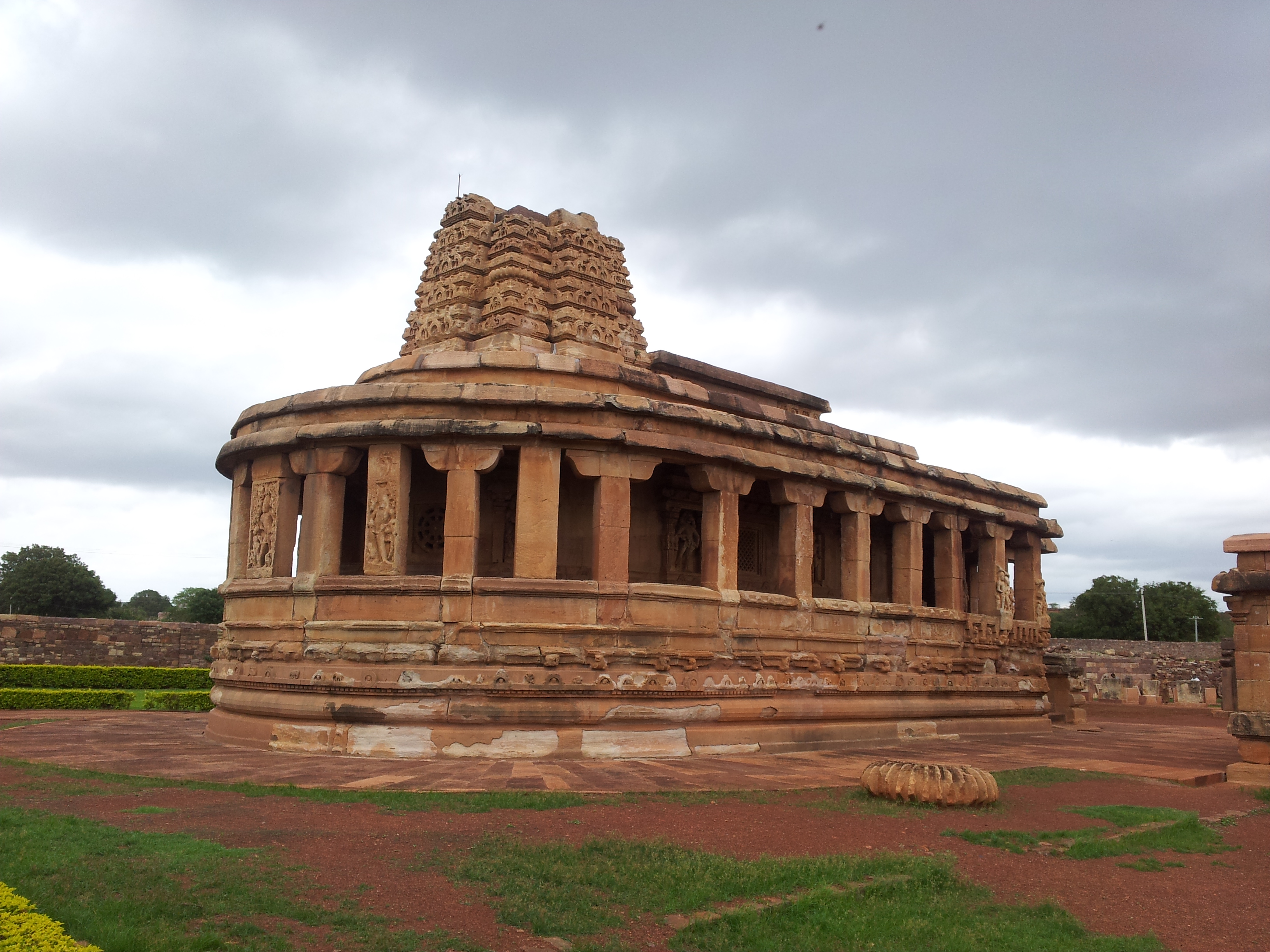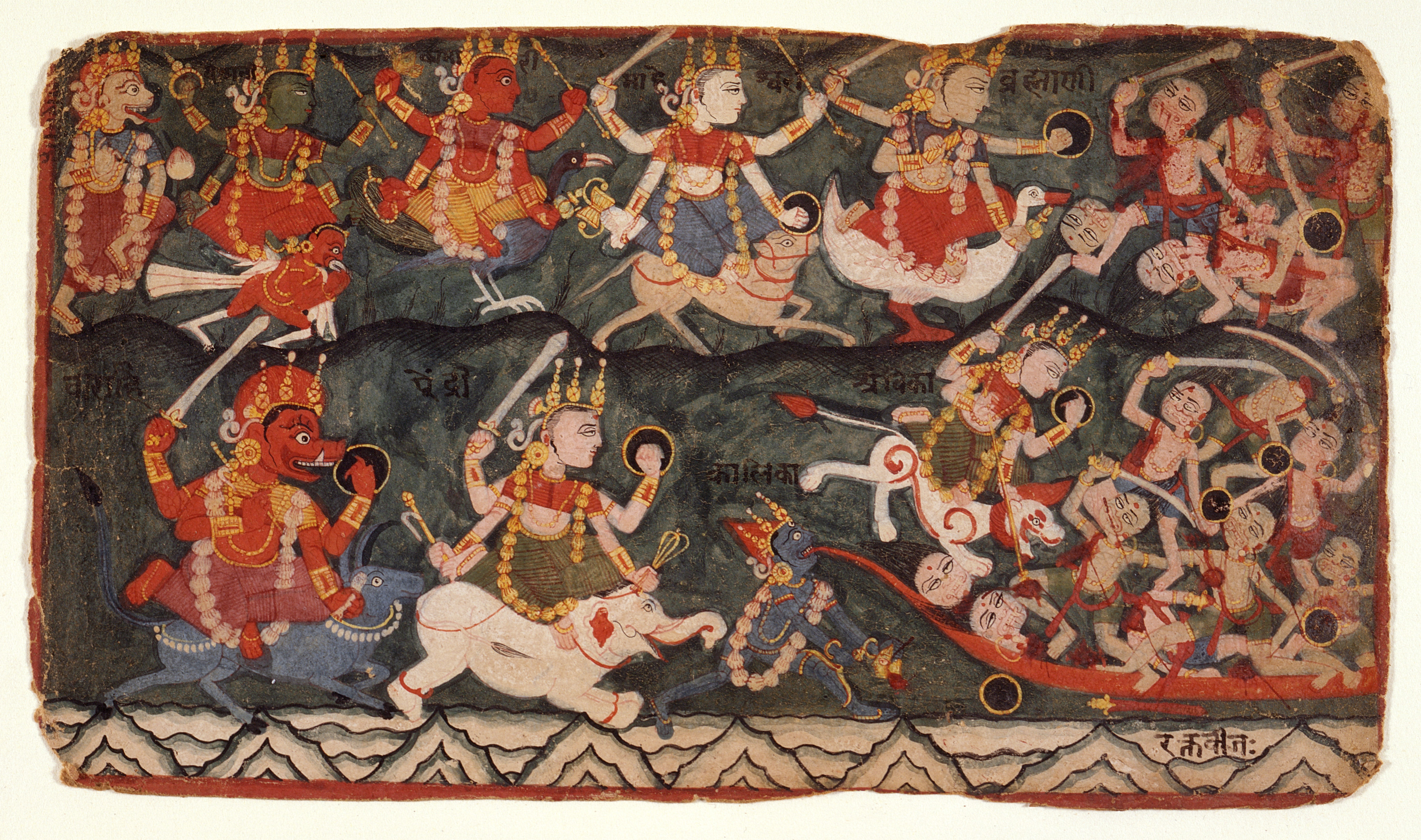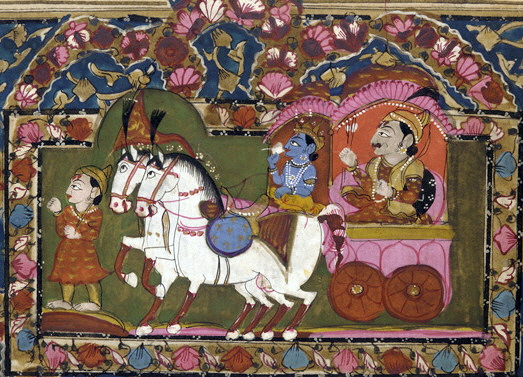|
Devimahatmya
The ''Devi Mahatmya'' or ''Devi Mahatmyam'' ( sa, देवीमाहात्म्यम्, devīmāhātmyam, Glory of the Goddess) is a Hindu philosophical text describing the Goddess as the supreme power and creator of the universe. It is part of the Markandeya Purana. ''Devi Mahatmyam'' is also known as the ''Durgā Saptashatī'' () or Śata Chandī (शत् चण्डी). The text contains 700 verses arranged into 13 chapters. Along with '' Devi-Bhagavata Purana'' and Shakta Upanishads such as the Devi Upanishad, it is one of the most important texts of Shaktism (goddess) tradition within Hinduism. The ''Devi Mahatmyam'' describes a storied battle between good and evil, where the Devi manifesting as goddess Durga leads the forces of good against the demon Mahishasura—the goddess is very angry and ruthless, and the forces of good win. In peaceful prosperous times, states the text, the Devi manifests as Lakshmi, empowering creation and happiness. The verses o ... [...More Info...] [...Related Items...] OR: [Wikipedia] [Google] [Baidu] |
Devimahatmya (Glory Of The Goddess) Manuscript LACMA M
The ''Devi Mahatmya'' or ''Devi Mahatmyam'' ( sa, देवीमाहात्म्यम्, devīmāhātmyam, Glory of the Goddess) is a Hindu philosophical text describing the Goddess as the supreme power and creator of the universe. It is part of the Markandeya Purana. ''Devi Mahatmyam'' is also known as the ''Durgā Saptashatī'' () or Śata Chandī (शत् चण्डी). The text contains 700 verses arranged into 13 chapters. Along with ''Devi-Bhagavata Purana'' and Shakta Upanishads such as the Devi Upanishad, it is one of the most important texts of Shaktism (goddess) tradition within Hinduism. The ''Devi Mahatmyam'' describes a storied battle between good and evil, where the Devi manifesting as goddess Durga leads the forces of good against the demon Mahishasura—the goddess is very angry and ruthless, and the forces of good win. In peaceful prosperous times, states the text, the Devi manifests as Lakshmi, empowering creation and happiness. The verses of this ... [...More Info...] [...Related Items...] OR: [Wikipedia] [Google] [Baidu] |
Markandeya Purana
The ''Markandeya Purana'' ( sa, मार्कण्डेय पुराण; IAST: ) is a Sanskrit text of Hinduism, and one of the eighteen major Puranas. The text's title Markandeya refers to a sage in Hindu History, who is the central character in two legends, one linked to Shiva and other to Vishnu. The Markandeya text is one of the Puranas that lacks a sectarian presentation of ideas in favor of any particular god, and it is rare to read any deity being invoked or deity prayers in the entire text. The Markandeya Purana is probably one of the oldest in Purana genre of Hindu Literature, among the most interesting and important, states Ludo Rocher. It is famous for including the Devi Mahatmya within it, the oldest known treatise on Devi (Goddess) as the Supreme Truth and Creator Of The Universe. The text is considered as a central text of the Hindu Goddess-related Shaktism tradition, with an extraordinary expression of reverence for the feminine. The Markandeya Purana' ... [...More Info...] [...Related Items...] OR: [Wikipedia] [Google] [Baidu] |
Shaktism
Shaktism ( sa, शाक्त, , ) is one of several major Hindu denominations, wherein the metaphysical reality is considered metaphorically a woman and Shakti (Mahadevi) is regarded as the supreme godhead. It includes many goddesses, all considered aspects of the same supreme goddess. Shaktism has different sub-traditions, ranging from those focused on most worshipped Durga, gracious Parvati to that of fierce Kali. The Sruti and Smriti texts of Hinduism are an important historical framework of the Shaktism tradition. In addition, it reveres the texts ''Devi Mahatmya'', the '' Devi-Bhagavata Purana'', '' Kalika Purana'' and Shakta Upanishads such as the Devi Upanishad. The ''Devi Mahatmya'' in particular, is considered in Shaktism to be as important as the ''Bhagavad Gita''. Shaktism is known for its various sub-traditions of tantra, as well as a galaxy of goddesses with respective systems. It consists of the Vidyapitha and Kulamārga. The pantheon of goddesses in ... [...More Info...] [...Related Items...] OR: [Wikipedia] [Google] [Baidu] |
Navratri
Navaratri is an annual Hindu festival observed in the honour of the goddess Durga. It spans over nine nights (and ten days), first in the month of Chaitra (March/April of the Gregorian calendar), and again in the month of Sharada. It is observed for different reasons and celebrated differently in various parts of the Hindu Indian cultural sphere. Theoretically, there are four seasonal ''Navaratri''. However, in practice, it is the post-monsoon autumn festival called Sharada Navaratri. The festival is celebrated in the bright half of the Hindu calendar month Ashvin, which typically falls in the Gregorian months of September and October. Etymology and nomenclature The word ''Navaratri'' means 'nine nights' in Sanskrit, ''nava'' meaning nine and ''ratri'' meaning nights. Dates and celebrations In the eastern and northeastern states of India, the Durga Puja is synonymous with ''Navaratri'', wherein goddess Durga battles and emerges victorious over the buffalo demon Ma ... [...More Info...] [...Related Items...] OR: [Wikipedia] [Google] [Baidu] |
Aihole
Aihole (pronounced "Eye-hoḷé"), also referred to as Aivalli, Ahivolal or Aryapura, is a historic site of ancient and medieval era Buddhist, Hindu and Jain monuments in Karnataka, India that dates from the sixth century through the twelfth century CE. Most of the surviving monuments at the site date from the 7th to 10th centuries. Located around an eponymous small village surrounded by farmlands and sandstone hills, Aihole is a major archaeological site featuring over one hundred and twenty stone and cave temples spread along the Malaprabha river valley, in Bagalakote district. Hunagunda Taluk Distance 35km Aihole is from Badami and about from Pattadakal, both of which are major centres of historically important Chalukya monuments. Aihole, along with nearby Badami (Vatapi), emerged by the 6th century as the cradle of experimentation with temple architecture, stone artwork, and construction techniques. This resulted in 16 types of free-standing temples and 4 types of ... [...More Info...] [...Related Items...] OR: [Wikipedia] [Google] [Baidu] |
Mahabharata
The ''Mahābhārata'' ( ; sa, महाभारतम्, ', ) is one of the two major Sanskrit epics of ancient India in Hinduism, the other being the '' Rāmāyaṇa''. It narrates the struggle between two groups of cousins in the Kurukshetra War and the fates of the Kaurava and the Pāṇḍava princes and their successors. It also contains philosophical and devotional material, such as a discussion of the four "goals of life" or ''puruṣārtha'' (12.161). Among the principal works and stories in the ''Mahābhārata'' are the ''Bhagavad Gita'', the story of Damayanti, the story of Shakuntala, the story of Pururava and Urvashi, the story of Savitri and Satyavan, the story of Kacha and Devayani, the story of Rishyasringa and an abbreviated version of the '' Rāmāyaṇa'', often considered as works in their own right. Traditionally, the authorship of the ''Mahābhārata'' is attributed to Vyāsa. There have been many attempts to unravel its historical growth ... [...More Info...] [...Related Items...] OR: [Wikipedia] [Google] [Baidu] |
Caṇḍī
Chandi ( sa, चण्डी, ) or Chandika () is a Hindu deity. Chandika is another form of Mahadevi, similar to Durga. Chandika is a powerful form of Mahadevi who manifested to destroy evil. She is also known as '' Kaushiki'', ''Katyayani'', ''Asthadasabuja'' ''Mahalakshmi'' and ''Mahishasuramardini''. History or is the name by which the Supremely divine is referred to in Devī Māhātmya. Chandi represents the killer of Chanda. ''Chanda'' and Munda were Ashur's strong army generals. The word Chandi also refers to the fiery power of anger of the Brahman. Bhaskararaya, a leading authority on matters concerning Devi worship, defines Chandi as 'the angry, terrible or passionate one'. While scholars debate whether an old Goddess was Sanskritized or a suppressed Goddess was reclaimed, the fact remains that since the very early days, the Devi was worshiped in the subcontinent regardless of whether she appears as a supreme deity in Brahminic texts. Scholars who trace her trac ... [...More Info...] [...Related Items...] OR: [Wikipedia] [Google] [Baidu] |
Shloka
Shloka or śloka ( sa, श्लोक , from the root , Macdonell, Arthur A., ''A Sanskrit Grammar for Students'', Appendix II, p. 232 (Oxford University Press, 3rd edition, 1927). in a broader sense, according to Monier-Williams's dictionary, is "any verse or stanza; a proverb, saying"; but in particular it refers to the 32-line verse, derived from the Vedic '' anuṣṭubh'' metre, used in the '' Bhagavad Gita'' and many other works of classical Sanskrit literature. In its usual form it consists of four ''pādas'' or quarter-verses, of 8 syllables each, or (according to an alternative analysis) of two half-verses of 16 syllables each. The metre is similar to the Vedic '' anuṣṭubh'' metre, but with stricter rules. The ''śloka'' is the basis for Indian epic poetry, and may be considered the Indian verse form ''par excellence'', occurring as it does far more frequently than any other metre in classical Sanskrit poetry. The ''śloka'' is the verse-form generally used in the ''M ... [...More Info...] [...Related Items...] OR: [Wikipedia] [Google] [Baidu] |
Tatpurusha
Sanskrit inherits from its parent, the Proto-Indo-European language, the capability of forming compound nouns, also widely seen in kindred languages, especially German, Greek, and also English. However, Sanskrit, especially in the later stages of the language, significantly expands on this both in terms of the number of elements making up a single compound and the volume of compound-usage in the literature, a development which is unique within Indo-European to Sanskrit and closely related languages. Further, this development in the later language is an entirely artificial, literary construct and does not reflect the spoken language.Burrow, p. 209. Background In Sanskrit, as in Proto-Indo-European, a compound is formed by the following process: * Take the stem-form of the first element, i.e., remove its inflexion; * Combine the two elements with a single accented syllable. In the later language, this process can be repeated recursively—in theory, ad infinitum, with the freshl ... [...More Info...] [...Related Items...] OR: [Wikipedia] [Google] [Baidu] |
Ātman (Hinduism)
''Ātman'' (; sa, आत्मन्) is a Sanskrit word that refers to the (universal) Self or self-existent essence of individuals, as distinct from ego (''Ahamkara''), mind (''Citta'') and embodied existence ('' Prakṛti''). The term is often translated as soul, but is better translated as "Self," as it solely refers to pure consciousness or witness-consciousness, beyond identification with phenomena. In order to attain moksha (liberation), a human being must acquire self-knowledge ('' Atma Gyaan or Brahmajnana''). ''Atman'' is a central concept in the various schools of Indian philosophy, which have different views on the relation between ''Atman'', individual Self ('' Jīvātman''), supreme Self (''Paramātmā'') and, the Ultimate Reality ('' Brahman''), stating that they are: completely identical (Advaita, Non-Dualist), completely different (Dvaita, Dualist), or simultaneously non-different and different ( Bhedabheda, Non-Dualist + Dualist). The six orthodox schoo ... [...More Info...] [...Related Items...] OR: [Wikipedia] [Google] [Baidu] |
Mahatma
Mahatma (English pronunciation: , sa, महात्मा, translit=mahātmā) is an honorific used in India. The term is commonly used for Mohandas Karamchand Gandhi, who is often referred to simply as "Mahatma Gandhi". Albeit less frequently, this epithet has also been used with regard to such people as Basava (1131–1167), Swami Shraddhanand (1856–1926), Lalon Shah (1772–1890), Ayyankali (1863–1941), and Jyotirao Phule (1827–1890). The term ''mahātmā'' has also been historically used for a class of religious scholars in Jainism; for the selected religious leaders in Theosophy; and for local religious teachers in the Divine Light Mission church. Etymology The term ''Mahatma'' derives from the Sanskrit terms महा (mahā), meaning "great" and आत्मा (ātmā), meaning "soul". In Theosophy The word, used in a technical sense, was popularized in theosophical literature in the late 19th century, when Helena Blavatsky, one of the founde ... [...More Info...] [...Related Items...] OR: [Wikipedia] [Google] [Baidu] |









